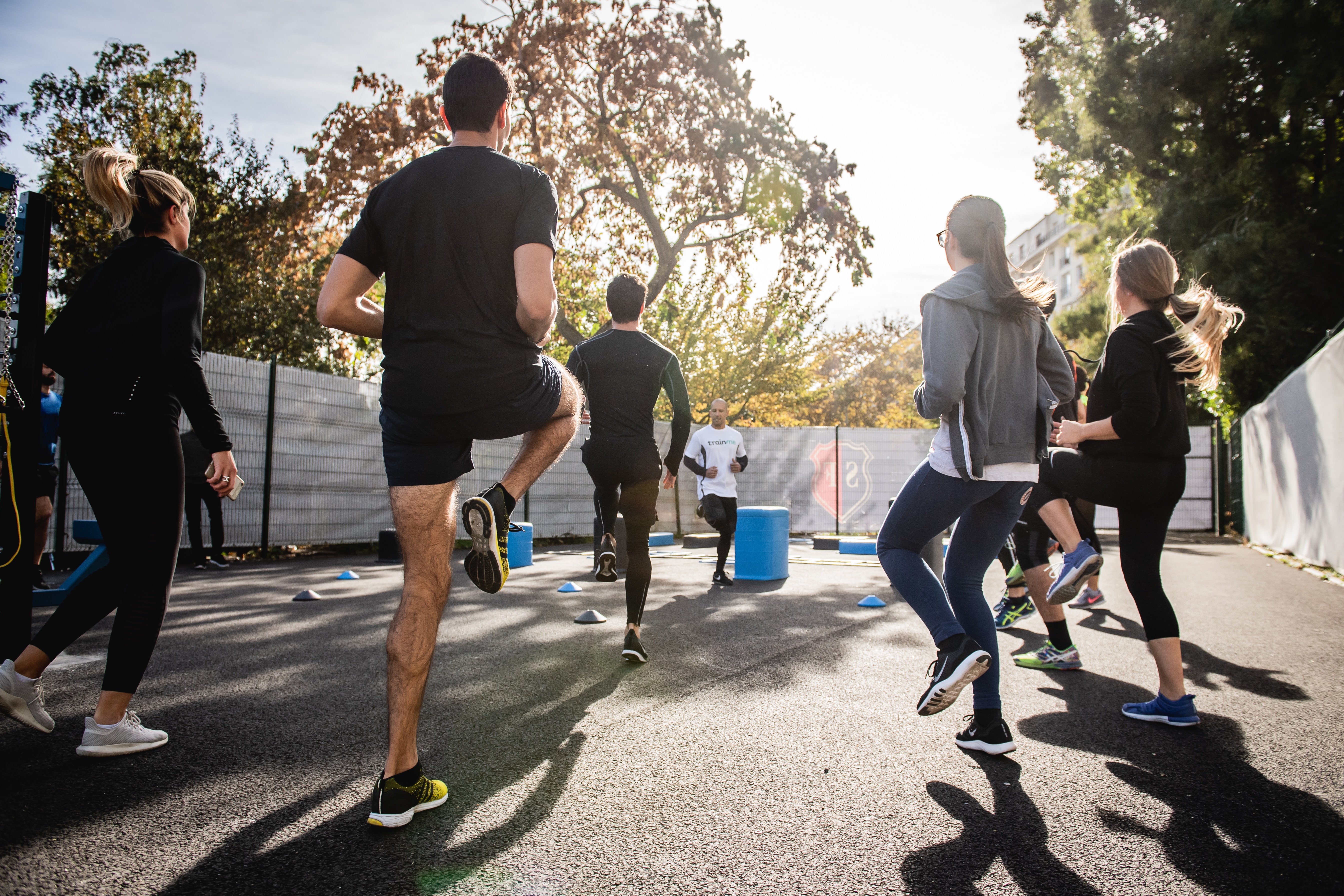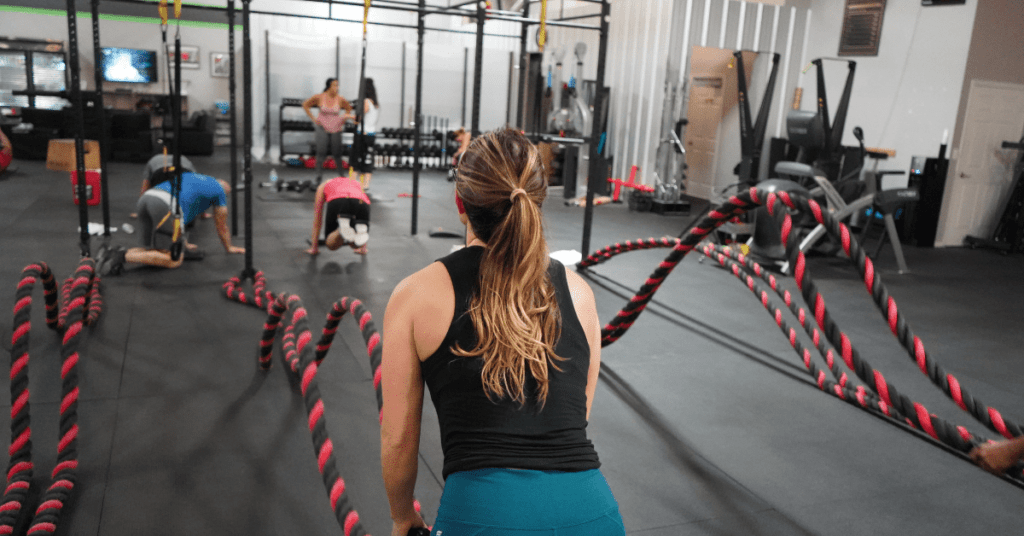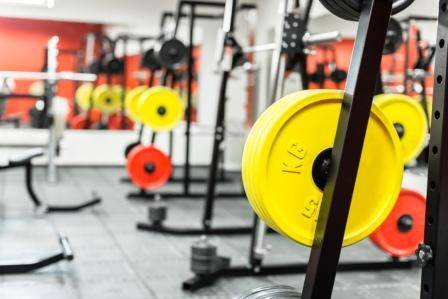The Availability of High School Fitness Facilities in Alberta, Canada

Previously published in Volume 87, Issue 2
Abstract
Many Canadian adolescents are insufficiently physically active. Socio-ecological models and approaches such as comprehensive school health suggest that schools may provide a supportive environment for encouraging activity, which includes decreasing barriers. Many high schools in North America have in-school fitness facilities and specialized staff that provide students with the opportunities and knowledge to become more active. The purpose of this study was to determine the number of Alberta high schools that have fitness facilities and employ specialized staff to run those facilities. An online survey was sent to Alberta high schools with a student population of greater than 800 students. Of the 26 schools that participated, 96% had an in-school fitness facility. Thirty-six percent of participating schools had a staff member dedicated to running the facility and providing physical activity supports. School facilities and staff could play a valuable role in addressing inactivity among adolescents; however, more research is needed.
Introduction
Physical activity (PA) is an important component of adolescent health and is associated with normal growth and development, improved body composition and higher cardiorespiratory and metabolic and musculoskeletal fitness (Poitras et al., 2016; Tremblay et al., 2011). In addition to physical benefits, PA has significant effects on adolescent mental health including lower depression and anxiety, lower psychological stress and an overall increase in well-being (Poitras et al., 2016). Despite the myriad of benefits that PA provides, the majority of Canadians are insufficiently active with only 33% of adolescents achieving a weekly average of the recommended amount of at least 60 minutes of moderate to vigorous PA (MVPA) per day (Colley et al., 2017). In Alberta, physical education (PE) is a curricular program that aims to “enable individuals to develop the knowledge, skills and attitudes necessary to lead an active, healthy lifestyle” (Alberta Learning, 2000) and is a required part of the curriculum up to and including grade 10 and optional in grades 11-12. Research shows a significant decline in Albertan PE enrollment once optional (Mandigo et al., 2004). Additionally, PA is known to decline as students age (Cumming et al., 2012; Fuller et al., 2011) as do participation rates in sport (Murphy et al., 2017). The reasons for this decline are complex, with researchers citing intrapersonal, social and environmental factors (Alberga et al., 2013; Sallis et al., 2000; Yungblut et al., 2012). However, this decline coupled with the known benefits of PA for adolescents emphasize the need for solutions to maintain or increase PA levels.
According to socio-ecological models, such as the Ecological Model of Physical Activity (Spence & Lee, 2003), multiple levels of the environment can have direct and indirect impacts on an individual's behavior (e.g., PA levels). Thus, schools may be ideal settings for health promotion as school-based interventions can support changes to the physical and social environments. More specifically, Comprehensive School Health (CSH) aims to improve the overall health and wellbeing of students and staff by addressing four components: social and physical environments, teaching and learning, policy, and partnerships and services (Joint Consortium School Health [JCSH], 2021). Interventions addressing CSH are effective for increasing PA and other health enhancing behaviors in students (Langford et al., 2015; McHugh et al., 2020) and may lead to better educational outcomes (Langford et al., 2015; Murray et al., 2007).
Though a number of core conditions for successful implementation of CSH have been identified (e.g., presence of a health champion), it is essential that context-specific decisions are made to ensure the best implementation for individual schools (Neely et al., 2020; Storey et al., 2016). This includes considering the unique context of secondary schools. Unfortunately, there is limited evidence for these programs’ effectiveness in secondary schools, as the majority of published studies have examined primary schools (Langford et al., 2015). Of those studies done in secondary schools, most involved individual PA interventions outside of the multi-level approach of CSH. For instance, schools that offered daily PE, or provided an alternate room for PA activities were associated with higher individual PA than schools that did not (Hobin et al., 2012).
The authors believe that the existence of in-school fitness facilities and the employment of specialized staff could have a significant impact on adolescent PA by addressing the social and physical environments of schools and providing resources to enhance teaching and learning. Researchers have stated the importance of providing accessible, safe and affordable opportunities to be active (Mehmeti & Halilaj, 2018; Piercy et al., 2018; Sallis et al., 2000), and in-school fitness facilities are a step towards improving overall school wellness (Best et al., 2001). Although these facilities have traditionally been used for athletic strength and conditioning (S&C), more schools are beginning to incorporate weight room skills and strength training activities into PE (Wade et al., 2014), and are opening up access to the general school population (Gentry & Escalante, 2018; Hunter et al., 2016; Lee et al., 2007).
Though estimates of high school fitness facilities in the United States vary from 65-95% (Judge et al., 2013; Lee et al., 2007; Weaver & DeBelisio, 2015), no studies have documented the prevalence of these facilities in Canada. However, a longitudinal study of school environments in Alberta and Ontario reported that 12 out of 86 schools either added, or improved the condition of their fitness centre over one year (Hunter et al., 2016).
Social support is a critical aspect of the school environment (Morton et al., 2015) and the existence of a specialized staff member that is focused on health promotion, including PA, is a valuable resource. For instance, female students who participated in a recent Manitoba study highlighted the positive impacts of a staff member dedicated to a high school fitness facility and described how they provided additional support and knowledge (Parsons & Ripat, 2020). In addition, several studies have emphasized the critical role that a health champion plays in successful CSH (Neely et al., 2020; Storey et al., 2016). Researchers have also emphasized the challenges of CSH on the workload of teachers and have highlighted the need for additional strategies (Higgens et al., 2014; Sulz et al., 2016).
In summary, fitness facilities can provide opportunities for increased school wellness, enhanced PE programs, and PA opportunities for the school community. However, a lack of understanding exists in the literature regarding Canadian high school facilities and staff roles. Therefore, the purpose of this study was to determine the proportion of large Alberta high schools that have fitness facilities and how these facilities are used and staffed.

Methods
Alberta high schools that had a grade 9-12 population of more than 800 students (n=76) in the 2019-2020 academic year were identified and recruited (Government of Alberta, 2020). A student population of at least 800 students was chosen for feasibility reasons and is also the cut-off used for classification of 4A schools by the Alberta Schools Athletic Association (ASAA, 2019). Schools that offered primarily outreach learning or adult learning were excluded.
School principals were emailed an information letter and an online link to a quantitative survey hosted on REDCap (Research Electronic Data Capture), which is a secure web-based software platform hosted at the University of Alberta (Harris et al., 2019; Harris et al., 2009). Principals were asked to forward the survey to the staff member most qualified to answer the questions or to complete it themselves. The survey included information on school demographics (e.g., school population), school fitness facilities (e.g., equipment, capacity, budget) and programs (e.g., extra-curricular clubs), and staffing of any school fitness facilities (e.g., job responsibilities). School fitness facilities were defined as a dedicated space other than gymnasium for S&C activities. Specialized staff were staff whose primary position was to run the fitness facility who were not employed in a teacher role (e.g., Athletic Therapists, S&C Professionals).
Due to the COVID-19 pandemic and the subsequent pausing of this study, some schools responded to the questionnaire in spring 2020, while the remaining schools were re-contacted in fall 2020. In addition, a manual search was conducted of websites, social media and school handbooks of schools that did not participate for terms such as “fitness centre”, “wellness centre” or “weight room” and for indications that the schools had a specialized staff member employed in March 2021. This information was used to supplement the survey.
The University of Alberta Research Ethics Board and the University of Alberta’s Cooperative Activities Board approved this study. Each school district was contacted to obtain permission to conduct this study prior to inviting principals to participate.
Results
Twenty-six out of 76 eligible schools participated in the survey resulting in a response rate of 34%. All but one of the schools had an in-school fitness facility (96%, n = 25) and 36% (n = 9) had a specialized staff member hired to run the facility. As of March 2021, a search of school websites and social media revealed that at least 41 additional schools had fitness facilities and an additional 10 schools had a specialized staff member. No inferential statistics were completed due to the small sample size.
The most common primary demographic for in-school fitness facilities was the general school population (39%, n = 9) followed closely by S&C classes (30%, n = 7; Table 1). Of the schools that responded to the additional questions in fall 2020, all schools with a fitness facility used those facilities for S&C classes regularly (if offered; 100%, n = 12) and for PE classes either on a regular basis (71%, n = 10) or sometimes (29%, n = 4). Most schools (89%, n = 16) provided extra-curricular access to the facility, while several ran PA clubs.
Most fitness facilities had a capacity of 15-30 (52%, n = 12) or 30-50 students (39%, n = 9). Most school fitness facilities had daily student use of less than 100 students (60%, n = 14) while one school (4%) had more than 200 students use the fitness facility daily. It was unclear if these were the same students each day, or multiple groups of students. Some participants drew attention to the high usage of their fitness facilities. “We have a very high demand for the weight room at our school. It is used all 4 periods of the day and before and after school.”

School fitness facilities reported a wide variety of type and amount of equipment. On average schools reported having 23 cardiovascular machines (range = 68) and 16 strength training machines (range = 23). No questions were asked regarding portable equipment such as dumbbells. Participants believed that more space (36%; n = 8) and a larger budget (36%; n = 8) would improve their school’s fitness facility the most. One participant specifically noted struggles with budget and funding constraints “we have a very small budget and are (sic) equipment is generally old and outdated.” Participants strongly agreed that having a fitness facility improved student and staff wellness, athletic performance and injury management as well as PE and other S&C classes.
For schools without a specialized staff member, the most common reasons were that ‘teachers provide all the services that this individual would provide’ followed closely by ‘not enough money’. One participant noted that “We need more than just volunteer coach/teacher time to have the fitness center used more. Hiring a person would increase use.” The most common benefit of having a staff member was ‘up to date training knowledge’ (89% n = 8; Table 2). It was apparent that these staff members had varied roles and responsibilities. The most common top job priority for specialized staff members was ‘fitness facility supervision and maintenance’ followed closely by ‘teacher and classroom support’ and ‘athletic therapy and/or sports injury management’ (Figure 1). In the nine schools with specialized staff, participants indicated that they supervised the fitness facility, provided S&C for athletics and supported teachers by assisting in S&C classes and the development of resources. Seven (88%) participants identified that they were responsible for general health and wellness while only four (50%) indicated that they provided extra-curricular PA opportunities. In schools without a specialized staff member, coaches and PE teachers most commonly assumed these responsibilities.
Discussion
To our knowledge, this study was the first to examine the prevalence of in-school fitness facilities in Canada and how they are used and staffed. The results of our survey combined with additional website and social media searches suggest that at least 87% of large Alberta high schools have in-school fitness facilities and at least 25% of large Alberta high schools have hired a staff member who is specifically responsible for running these facilities. This is on par with studies on the prevalence of facilities in American schools (Hood et al., 2014; Judge et al., 2013; Lee et al., 2007), and aligns with commentaries suggesting that these facilities are being used for PE as well as general school PA and wellness promotion (Gentry & Escalante, 2018). In the following, we discuss implications within the context of two of the four components of CSH: i.e., physical and social environments, and teaching and learning. Though we did not ask about policy related to facilities, nor partnerships and services, the relevance of these additional components of CSH to our topic are areas of future research. For instance, policies and partnerships have the potential to support joint-use agreements between municipalities and schools and could alleviate barriers related to budget.
Physical and Social Environments
The availability of these facilities has promising implications for adolescent PA, especially when considering PA within the context of a CSH approach. In-school fitness facilities could support teaching and learning and build strong and supportive social and physical environments. For instance, several studies have found that a high prevalence of indoor facilities is correlated with higher MVPA (Haug et al., 2008; Hood et al., 2014) and the specific presence of a weight room in a high school was associated with higher levels of PA (Haug et al., 2008; Hobin et al., 2012).
A specialized staff member plays an integral role in creating a supportive social environment. Many studies suggest a supportive social environment, including positive relationships with staff, is essential in encouraging adolescents to increase and enjoy PA (Morton et al., 2016; Sallis et al., 2000). Likewise, multiple studies have emphasized the importance of having a champion to support the implementation of CSH to promote school health (Neely et al., 2020; Storey et al., 2016). Participants in Parsons’ and Ripat’s (2020) examination of this role described how the presence of a female exercise specialist in their school eased students’ feelings of intimidation by providing knowledge and support and helped them develop confidence. Thus, the specialized staff member has the potential to guide and encourage students towards greater lifetime PA by teaching appropriate S&C methods, educating on the benefits of proper nutrition and healthy lifestyles and creating a supportive and empowering environment.
Teaching and Learning
In-school fitness facilities are an integral part of PE and other PA courses. Teaching the basics of S&C activities in quality facilities supports the curricular requirement of teaching a variety of individual pursuits (Alberta Learning, 2000) and could be an excellent way of encouraging students to continue these activities after graduation. For instance, Parsons and Ripat (2020) found that intentional strategies such as mandatory visits to the in-school fitness facility in PE resulted in increased confidence and excitement to visit community facilities after graduation for female high school students. Employing a specialized staff in these facilities may also be a strategy to decrease teacher workload in curricular and extra-curricular activities.
Equity and Safety Concerns
The wide differences in the amount of equipment and facility capacity between schools in our research raises questions of equity. Varied equipment and capacity could result in some schools providing better spaces and thus greater impacts on student PA. It is likely that the size and quality of fitness facilities are impacted by measures such as administrator support, or the socio-economic status (SES) of the school neighbourhood. Since many adolescents living in low SES circumstances struggle to access sports and other organized PA opportunities due to cost (Bengoechea et al., 2013; Clarke, 2008; Clarke et al., 2019; Stalsberg & Pederson, 2010), school environments may buffer these economic disparities by providing low-cost accessible PA options. Thus, ensuring that schools offer equitable access to good facilities is essential.
Although S&C activities are safe for adolescents, qualified supervision and instruction is essential (Faigenbaum et al., 2009; Lloyd et al., 2103). Our research demonstrated that in schools without a specialized staff member, supervision was the responsibility of PE teachers, or in some cases other teachers or coaches. It is unclear what knowledge or skills these supervisors may hold, and whether or not they provide active, quality exercise instruction or passive supervision. Research suggests that many PE teachers, coaches or other staff are inadequately prepared for these duties (McGladrey et al., 2014) and that the quality and implementation of S&C in high schools without a certified professional may be ineffective (Hartshorn et al., 2016; Wade et al., 2014). Thus, relying on teachers and coaches to fill additional responsibilities may not always provide the safest environment.
Implications
The prevalence of in-school fitness facilities and the lack of dedicated and qualified staff overseeing these facilities indicates a need for increased focus on appropriate supervision, S&C methodology and PA promotion for adolescents. School districts and administrators should consider the immense value that this position could bring to the health and learning of students. However, while increasing the presence of specialized staff in school fitness facilities is ideal, participants indicated that school budgets were a main barrier in employing specialized staff. Thus, until this position becomes more widespread, it is imperative that resources for teachers are made available to ensure safe and effective courses and extra-curricular programs. Alternatively, qualified S&C professionals could be brought in as guest speakers to support teacher professional development or to support classes in learning the basics of S&C concepts. Ultimately, it would be beneficial to create a network of specialized fitness facility staff, PE teachers and coaches who are involved in the running of high school fitness facilities to create and implement new ideas and resources. Sharing resources across the province and within school districts via professional development and pre-service learning opportunities would be great first steps.
Strengths and Limitations
This is the first study to examine the use of in-school fitness facilities and how they are staffed in Albertan high schools. Strengths of this research include a moderate response rate and a sample that is representative of large schools across the province. The addition of a website and social media search increased our confidence that the high proportion of high schools with fitness facilities was not due to response bias. However, this study is not without its limitations. First, the cross-sectional design did not allow for discussion of causation or impact of changes over time. In addition, as there was no requirement as to which staff member should complete the survey the findings may be biased depending on which staff member answered the questions.
Conclusion
This study provides a glimpse into Alberta high school fitness facilities and their staff and highlights the potential for increasing adolescent PA through the physical and social environment. Though many high schools appear to have fitness facilities, it is essential that schools ensure that they are staffed in ways that safely and equitably support adolescent PA while simultaneously supporting teachers. Ultimately, further research on the availability of in-school fitness facilities and impacts on student behaviour is needed, including research on smaller schools and the wider Canadian context. Qualitative studies may be best suited to understand the nuances around beliefs and impacts that are not easily measured.
References
Alberga, A., Medd, E., Adamo, K., Goldfield, G., Prud’homme, D., Kenny, G., & Sigal, R. (2013). Top 10 practical lessons learned from physical activity interventions in overweight and obese children and adolescents. Applied Physiology, Nutrition and Metabolism, 38, 249-258.
Alberta Learning (2000). Physical Education. Retrieved March 30, 2021 from https://education.alberta.ca/media/160191/phys2000.pdf
ASAA (2019). ASAA 2019-20 Policy Handbook. Retrieved May 30, 2021 from https://www.asaa.ca/sites/default/files/uploads/basic/attachments/policy_handbook_2020-21_0.pdf
Best, R., Beaver, D., Caza, A., Harbach, B., Harris, R., Intemann, M., Latta, E., Meadors, L., Nitka,M., Nunnink, S., Riehl, M. & Rogers, L. (2001). The high school strength and conditioning professional: A job description. Strength and Conditioning Journal, 23(3), 7-10.
Bengoechea, E.G., Sabiston, C., Ahmed, R. & Farnoush, M. (2010). Exploring links to unorganized and organized physical activity during adolescence. Research Quarterly for Exercise and Sport, 81(1), 7-16. https://doi.org/10.1080/02701367.2010.10599623
Canadian Public Health Association. (1986). Ottawa charter for health promotion. Canadian Journal of Public Health, 77(6), 425-430.
Clarke, W. (2008). Kid’s sports. Canadian Social Trends. Statistics Canada, Catalogue no. 11-008-X.
https://www150.statcan.gc.ca/n1/en/pub/11-008-x/2008001/article/10573- eng.pdf?st=vBDeKkvn
Clarke, M., Costas-Bradstreet, C., Holt, N, & Spence, J. (2019). Parental perceptions of a national program that funds sport participation for low-income children and youth in Canada. Leisure Sciences. https://doi.org/10.1080/01490400.2019.1700573
Colley, R., Carson, V., Garriguet, D., Janssen, I., Roberts, K. & Tremblay, M. (2017). Physical activity of Canadian children and youth, 2007-2015. Health Reports Statistics Canada, 28(10), 8-16.
Cumming, S.P., Sherar, L.B., Pindus, D.M., Coelho-e-Silva, M.J., Malina, R.M., Jardine, P.R. (2012). A biocultural model of maturity-associated variance in adolescent physical activity. International Review Sport Exerciser Psychology, 5(1):23–43.
Faigenbaum, A., Kraemer, W., Blimkie, C., Jeffreys, I., Micheli, L., Nitka, M., & Rowland, T. (2009). Youth resistance training: Updated position statement paper from the National Strength and Conditioning Association. Journal of Strength and Conditioning Research, 23(5), 60-79.
Fuller, D., Sabiston, C., Karp, I., Barnett, T., & O’Loughlin, J. (2011). School sports opportunities influence physical activity in secondary school and beyond. Journal of School Health, 81, 449-454.
Gentry, C. & Escalante, G. (2018). The weight room: Preparing students for physical activity beyond physical education. Journal of Physical Education, Recreation & Dance, 89(6), 62-65.
https://doi.org/10.1080/07303084.2018.1478568
Government of Alberta (2020). School and authority enrollment data. Retrieved August 1, 2020 from https://www.alberta.ca/student-population-statistics.aspx?utm_source=redirector#toc-2
Harris, PA., Taylor, R., Thielke, R., Payne, J., Gonzalez, N., Conde, JG. (2009). A metadata driven methodology and workflow process for providing translational research informatics support. Journal of Biomedical Information, 42(2), 377-81.
Harris, PA., Taylor, R., Minor, BL., Elliott, V., Fernandez, M., O’Neal, L., McLeod, L., Delacqua, G., Delacqua, F., Kirby, J., Duda, SN. (2019). REDCap Consortium, The REDCap consortium: Building an international community of software partners, Journal of Biomedical Information. https://doi.org/10.1016/j.jbi.2019.103208
Hartshorn, M., Read, P., Bishop, C. & Turner, A. (2016). Profile of a strength and conditioning coach: Backgrounds, duties and perceptions. Strength and Conditioning Journal, 38(6), 89-94.
Haug, E., Torsheim, T. & Samdal, O. (2008). Physical environmental characteristics and individual interests as correlates of physical activity in Norwegian secondary schools: The health behaviour in school-aged children study. International Journal of Behavioral Nutrition and Physical Activity, 5(47). https://doi.org/10.1168/1479-5868-5-47
Higgens, J., Naylor, P., Riecken, K., Gibbons, S., Rhodes, R., Sulz, L. & McKay, H. (2014).
One, two, three strikes and you’re out? Examining youth physical activity in the context of the health promoting secondary schools model and teacher job action. Education and Health, 32 (3):110-117.
Hobin, E., Leatherdale, S., Manske, S., Dubing, J., Elliott, S. & Veugelers, P (2012). A multilevel examination of factors of the school environment and time spent in moderate to vigorous physical activity among a sample of secondary school students in grades 9-12 in Ontario, Canada. International Journal of Public Health, 57, 699-709.
Hood, N., Colabianchi, N., Terry-McElrath, Y., O’Malley, P. & Johnston, L. (2014). Physical activity breaks and facilities in US secondary schools. Journal of School Health, 84, 697-705.
Hunter, S., Leatherdale, S., Storey, K. & Carson, V. (2016). A quasi-experimental examination of how school-based physical activity changes impact secondary school student moderate to vigorous intensity physical activity of time in the COMPASS study. International
Journal of Behavioral Nutrition and Physical Activity, 13(86). https://doi.org/10.1186/s12966-016-0411-9
Joint Consortium for School Health. (2016). What is comprehensive school health? Retrieved April 24, 2021 from: http://www.jcsh-cces.ca/images/What_is_Comprehensive_School_Health_-_2-pager_-_July_2016.pdf
Judge, L., Petersen, J., Bellar, D., Craig, B. & Gilreath, E. (2013). CSCS certification and school enrollment impacts upon high school strength facilities, equipment and safety. Journal of Strength and Conditioning Research, 27(9), 2626-2633.
Langford, R., Bonell, C., Jones, H., Pouliou, T., Murphy, S., Waters, E., Komro, K., Gibbs, L., Magnus, D. & Campbell, R. (2015). The World Health Organization’s Health Promoting Schools framework: a Cochrane systematic review and meta-analysis. BMC Public Health, 15(130).
Lee, S., Burgeson, C., Fulton, J. & Spain, C. (2007). Physical education and physical activity: Results from the school health policies and programs study 2006. Journal of School Health, 77(8), 435-463.
Lloyd, R., Faigenbaum, A., Stone, M., Oliver, J., Jeffreys, I., Moody, J., Brewer, C., Pierce, K., McCambridge,T., Howard, R., Herrington, L., Hainline, B., Micheli, L., Jaques, R., Kraemer,W., McBridge, M., Best, T., Chu, D., Alvar, B. &Myer, G. (2013). Position statement on youth resistance training: The 2014 international consensus. British Journal of Sports Medicine, 48, 498-505. https://doi.org/10.1136/bjsports- 2013-092952
Mandigo, J., Spence, J., Thompson, L., Melnychuk, N., Schwartz, M., Marshall, D., Causgrove Dunn, J. (2004). Factors influencing the delivery and content of physical education classes in Alberta. Avante, 10(1), 1-15.
McGladrey, B., Hannon, J., Faigenbaum, A., Shultz, B. & Shaw, J. (2014). High school physical educators’ and sport coaches’ knowledge of resistance training principles and methods.
Journal of Strength and Conditioning Research, 28(5), 1433-1442.
McHugh, C., Hurst, A., Bethel, A., Lloyd, J., Logan, S. & Wyatt, K. (2020). The impact of the World Health Organization Health Promoting Schools framework approach on diet and physical activity behaviours of adolescents in secondary schools: A systematic review. Public Health, 182, 116-124.
Mehmeti, I., & Halilaj, B. (2018). How to increase motivation for physical activity among youth. Sport Mont, 16, 29-32.
Morton, K., Atkin, A., Corder, K., Suhroke, M. & van Sluijs. (2015). The school environment and adolescent physical activity and sedentary behavior: A mixed-studies systematic review. Obesity Reviews, 17¸ 142-158.
Murphy, M., Rowe, D., & Woods, C. (2017). Impact of physical activity domains on subsequent physical activity in youth: A 5-year longitudinal study. Journal of Sports Sciences, 35(3), 262-268.
Murray, N., Low, B., Hollis, C., Cross A. & Davis, S. (2007). Coordinated school health programs and academic achievement: A systematic review of the literature. Journal of School Health, 77, 589-600.
Neely, K., Montemurro, G., & Storey, K. (2020). A Canadian-wide perspective on the essential conditions for taking a comprehensive school health approach. BMC Public Health, 20: 1907. https://doi.org/10.1186/s12889-020-09987-6
Parsons, J. & Ripat, J. (2020). Understanding the experiences of girls using a high school weight room. Physical Health and Education Journal, 86(2).
Piercy, K., Troiano, R., Ballard, R., Carlson, S., Fulton, J., Galuska, D., George, S., Olson, R. (2018). The physical activity guidelines for Americans. Journal of American Medical Association, 320(19), 2020-2028.
Poitras, V., Gray, C., Borghese, M., Carson, V., Chaput, J., Janssen, I… Tremblay, M. (2016). Systematic review of the relationships between objectively measured physical activity and health indicators in school-aged children and youth. Journal of Applied Physiology, Nutrition and Metabolism, 41, S197-S239.
Sallis, J., & Owen, N. (2015). Ecological models of health behavior. In Glanz, K., Rimer, B. K., & Viswanath, K. (Eds.). Health behavior: Theory, research, and practice (5th ed.). San Francisco, CA: Jossey-Bass Publishers.
Sallis, J., Prochaska, J., & Taylor, W. (2000). A review of correlates of physical activity of children and adolescents. Medicine and Science in Sport and Exercise, 32(5), 963-975.
Spence, J. C., & Lee, R. E. (2003). Toward a comprehensive model of physical activity. Psychology of Sport and Exercise, 4, 7-24.
Stalsberg,R. & Pedersen, A. (2010). Effects of socioeconomic status on the physical activity of adolescents: a systematic review of the evidence. Scandinavian Journal of Medicine and Science in Sports, 20, 368-383. https://doi.org/10.1111/j.1600-0838.2009. 01047.x
Storey, K., Montemurro, G., Flynn, J., Schwartz, M., Wright, E., Osler, J., Veugelers, P. & Roberts, E. (2016). Essential conditions for the implementation of comprehensive school health to achieve changes in school culture and improvements in health behaviours of students. BMC Public Health, 16:1133. https://doi.org/10.1186/s12889-016-3787-1
Sulz, L., Gibbons, S., Naylor, P., Higgens, J. (2016). Complexity of choice: Teachers’ and students’ experiences implementing a choice-based comprehensive school health model. Health Education Journal, 75(8): 986-997. https://doi.org/ 10.1177/0017896916645936
Tremblay, M., Warburton, D., Janssen, I., Paterson, D., Latimer, A., Rhodes, R…Duggan, M. (2011). New Canadian physical activity guidelines. Journal of Applied Physiology, Nutrition and Metabolism, 36, 36-46.
Wade, S., Pope, Z., and Simonson, S. (2014). How prepared are college freshmen athletes for the rigors of college strength and conditioning? A survey of college strength and conditioning coaches. Journal of Strength Conditioning Research, 28(10), 2746–2753.
Weaver, E. & DeBeliso M. (2015). Survey of Utah high school football strength and conditioning coaches. Journal of Sports Sciences, 3(3), 117-126. https://doi.org/10.17265/2332-7839/2015.03.002
Yungblut, H., Schinke, R., McGannon, K. (2012). Views of adolescent female youth on physical activity during adolescence. Journal of Sports Science and Medicine, 11, 39-50.
Table 1
Fitness Facility Characteristics
n
%
Length of time
0-5 years
2
15.4
6-15 years
3
23.1
15-20 years
3
23.1
20+ years
5
38.5
Capacity
15-30
12
52.2
30-50
9
39.1
50+
2
8.6
Daily student use
25-50
4
17.4
50-75
6
26.1
75-100
4
17.4
100-150
4
17.4
150+
3
13.0
We do not track use
2
8.7
Primary demographic
Athletes
0
0
General school population
9
39.1
Pe classes
6
26.1
Sport performance classes
7
30.4
Staff
1
4.3
Facility hoursa
After school
13
56.5
Before school
7
30.4
During classes
13
56.5
Only when a teacher
Is willing to supervise
10
43.5
Not open for general use
3
13.0
This question allowed multiple responses, as such, % of all responses is reported.
Table 2
Benefits of a Specialized Fitness Facility Staffab
Benefits
n
%
Up to date training knowledge
8
88.9
Teacher support
6
66.7
First aid support
7
77.8
First aid training
3
33.3
Staff and student wellness initiatives
6
66.7
Sport trainer for athletic injuries
5
55.6
Strength and conditioning programs
7
77.8
Other
2
22.2
Total
44
488.9
Staff Member = Yes
This question allowed multiple responses, as such, % of all responses is reported.
Dichotomy group tabulated at value 1.
Figure 1
Staff Job Priorities









